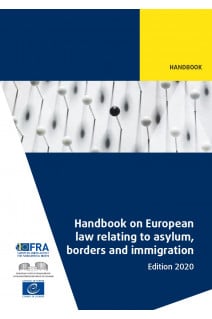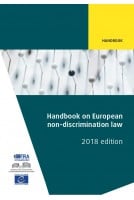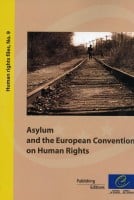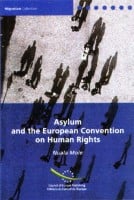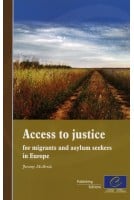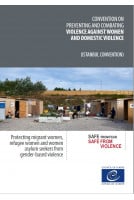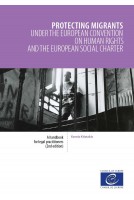FOREWORD ABBREVIATIONS HOW TO USE THIS HANDBOOK INTRODUCTION
The Council of Europe
The European Union
The Charter of Fundamental Rights of the European Union
European Union accession to the European Convention on Human Rights
Key points
1 ACCESS TO THE TERRITORY AND TO PROCEDURES
Introduction
1.1. The Schengen visa regime
1.2. Preventing unauthorised entry
1.3. Entry bans and Schengen alerts
1.4. Checks at border-crossing points
1.5. Internal borders within the Schengen area
1.6. Local border traffic
1.7. Transit zones
1.8. Access to asylum
1.9. Push-backs and pull-backs at sea
Key points
2 LARGE-SCALE EU INFORMATION TECHNOLOGY SYSTEMS AND INTEROPERABILITY
Introduction
2.1. Large-scale EU information systems
2.1.1. European Asylum Dactyloscopy (Eurodac)
2.1.2. Visa Information System (VIS)
2.1.3. Schengen Information System (SIS)
2.1.4. Entry/Exit System (EES)
2.1.5. European Travel Authorisation and Information System (ETIAS)
2.1.6. European Criminal Records Information System on Third-Country Nationals (ECRIS-TCN)
2.1.7. Europol Information System (EIS)
2.2. Interoperability
2.2.1. Common Identity Repository
2.2.2. European Search Portal
2.2.3. Multiple-Identity Detector
2.2.4. Shared Biometric Matching Service
2.3. Oversight
2.4. Purpose limitation, data minimisation and data accuracy
2.5. Right to information
2.6 Access to data
2.7. Data transfers to third parties
2.8. Data subjects’ rights
Key points
3 STATUS AND ASSOCIATED DOCUMENTATION
Introduction
3.1. Asylum seekers
3.2. Recognised refugees and those recognised as being in need of subsidiary protection
3.3. Victims of trafficking and of particularly exploitative labour conditions
3.4. Persons affected by Rule 39 interim measures
3.5. Migrants in an irregular situation
3.6. Long-term residents
3.7. Turkish nationals
3.8. British nationals
3.9. Third-country nationals who are family members of EEA or Swiss nationals
3.10. Stateless persons and the loss of citizenship or documentation
Key points
4 ASYLUM DETERMINATION AND BARRIERS TO REMOVAL: SUBSTANTIVE ISSUES
Introduction
4.1. The right to asylum and the principle of non-refoulement
4.1.1. The nature of the risk under EU law
4.1.2. The nature of the risk under the ECHR
4.1.3. Assessment of risk
4.1.4. Sufficiency of protection
4.1.5. Internal relocation
4.1.6. Safety elsewhere
4.1.7. Exclusion from international protection
4.1.8. Cessation of international protection
4.2. Collective expulsion
4.3. Barriers to expulsion based on other human rights grounds
4.4. Third-country nationals who enjoy a higher degree of protection from removal
4.4.1. Long-term residents
4.4.2. Third-country national family members of EEA and Swiss nationals
4.4.3 Turkish nationals
Key points
5 PROCEDURAL SAFEGUARDS AND LEGAL SUPPORT IN ASYLUM AND RETURN CASES
Introduction
5.1. Asylum procedures
5.1.1. Interview, examination procedure and initial decision-making
5.1.2. Right to an effective remedy
5.1.3. Appeals with automatic suspensive effect
5.1.4. Accelerated asylum procedures
5.2. Dublin procedure
5.3. Procedures relating to reception conditions of asylum seekers
5.4. Return procedures
5.5. Legal assistance in asylum and return procedures
5.5.1. Legal assistance in asylum procedures
5.5.2. Legal assistance in return procedures
5.5.3. Legal assistance to challenge reception conditions
Key points
6 PRIVATE AND FAMILY LIFE AND THE RIGHT TO MARRY
Introduction
6.1. The right to marry and to found a family
6.2. Family regularisation
6.3. Family reunification
6.4. Maintaining the family – protection from expulsion
6.4.1. Relationship breakdown
6.4.2. Criminal convictions
Key points
7 DETENTION AND RESTRICTIONS TO FREEDOM OF MOVEMENT
Introduction
7.1. Deprivation of liberty or restriction on the freedom of movement?
7.2. Alternatives to detention
7.3. Exhaustive list of exceptions to the right to liberty
7.3.1. Detention to prevent an unauthorised entry into the country
7.3.2. Detention pending removal or extradition
7.4. Prescribed by law
7.5. Necessity and proportionality
7.6. Arbitrariness
7.6.1. Good faith
7.6.2. Due diligence
7.6.3. Realistic prospect of removal
7.6.4. Maximum length of detention
7.7. Detention of individuals with specific needs
7.8. Procedural safeguards
7.8.1. Right to be given reasons
7.8.2. Right to review of detention
7.9. Detention conditions or regimes
7.10. Compensation for unlawful detention
Key points
8 FORCED RETURNS AND MANNER OF REMOVAL
Introduction
8.1. Carrying out removal: safe, dignified and humane
8.2. Confidentiality
8.3. Serious harm caused by restraint measures
8.4. Investigations
Key points
9 ECONOMIC AND SOCIAL RIGHTS
Introduction
9.1. Main sources of law
9.2. Economic rights
9.2.1. Family members of EEA and Swiss nationals
9.2.2. Posted workers
9.2.3. Blue Card holders, researchers and students
9.2.4. Turkish nationals
9.2.5. Long-term residents and beneficiaries of the Family Reunification Directive
9.2.6. Nationals of other countries with association or cooperation agreements
9.2.7. Asylum seekers and refugees
9.2.8. Migrants in an irregular situation
9.3. Education
9.4. Housing
9.5. Healthcare
9.6. Social security and social assistance
Key points
10 PERSONS WITH SPECIFIC NEEDS
Introduction
10.1. Unaccompanied children
10.1.1. Reception and treatment
10.1.2. Age assessment
10.2. Victims of trafficking in human beings
10.3. Persons with disabilities
10.4. Victims of torture
10.5. Victims of gender-based violence
Key points
FURTHER READING ONLINE SOURCES LIST OF CASES HOW TO FIND CASE LAW OF THE EUROPEAN COURTS EU INSTRUMENTS AND SELECTED AGREEMENTS ANNEXES
ANNEX 1: APPLICABILITY OF EU REGULATIONS AND DIRECTIVES CITED IN THIS HANDBOOK
ANNEX 2: APPLICABILITY OF SELECTED COUNCIL OF EUROPE INSTRUMENTS
ANNEX 3: ACCEPTANCE OF ESC PROVISIONS
ANNEX 4: ACCEPTANCE OF SELECTED UN CONVENTIONS
ANNEX 5: COUNTRY CODES USED IN THE ANNEXES
